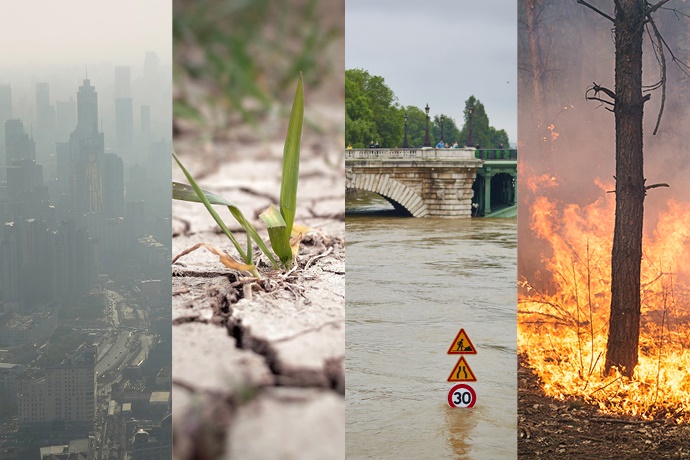

How does ECMWF contribute to the Copernicus programme?
ECMWF runs two services that are part of the EU’s Copernicus Earth observation programme. They are the Copernicus Atmosphere Monitoring Service (CAMS) and the Copernicus Climate Change Service (C3S). CAMS provides consistent and quality-controlled information related to air pollution and health, solar energy, greenhouse gases and climate forcing. C3S delivers authoritative information about the past, present and future climate, as well as tools to enable climate change mitigation and adaptation. ECMWF also contributes to early warning systems for flood awareness and forest fire information provided by the Copernicus Emergency Management Service (CEMS).
Which key services does CAMS provide?
Twice a day, CAMS issues a worldwide forecast of the composition of the atmosphere over the next five days. In addition, it uses regional production systems to provide daily forecasts of air quality across Europe. It also monitors levels of carbon dioxide and methane in the atmosphere and simulates concentrations of the two greenhouse gases. It is currently developing a new global monitoring and verification support capacity of anthropogenic carbon dioxide and methane emissions using observations and computer models. This new capacity will deliver consistent and reliable information to support policy- and decision-making processes. Finally, CAMS provides a global reanalysis of atmospheric composition from 2003 to the present day.
Which key services does C3S provide?
C3S provides a comprehensive record of the climate since the middle of the last century in the form of reanalyses. These are datasets describing the atmosphere, land surface and ocean waves. They include ECMWF’s ERA5 global reanalysis, ERA5-Land, regional reanalysis data for Europe, and a regional reanalysis for two subdomains of the Arctic. The latest reanalysis data are available in up-to-date climate bulletins, and the European State of the Climate provides yearly summaries. In addition, numerous datasets describing the past, the present and potential futures are included in the Climate Data Store (CDS). The CDS includes many applications as well as datasets from a range of sources. Using the CDS Toolbox, users can create their own applications using available data.
How are CAMS and C3S linked to ECMWF?
Both CAMS and C3S have grown out of activities ECMWF was engaged in beforehand. For example, as part of the EU-funded Monitoring Atmospheric Composition and Climate (MACC) projects, ECMWF included a detailed representation of atmospheric composition in its Integrated Forecasting System (IFS). In 2014, the year CAMS and C3S were founded, it launched Composition-IFS (C-IFS). This was one of the first examples of a new class of global forecasting systems capable of delivering weather and environmental services. ECMWF also has a long history of providing global reanalyses. The first one was completed in the 1980s, followed by ERA-15 in 1995 and ERA-40 in 2002. ERA-Interim started to be produced in 2006, and by 2020 ECMWF scientists working for C3S had created the ERA5 reanalysis, which is one of the cornerstones of C3S.
How does ECMWF contribute to CEMS?
ECMWF is contributing to some of the services CEMS delivers as part of its early warning and monitoring activities. These are the European Flood Awareness System (EFAS), the Global Flood Awareness System (GloFAS), the European Forest Fire Information System (EFFIS) and the Global Wildfire Information System (GWIS). ECMWF is the computational centre of EFAS and GloFAS. The flood services work by combining ECMWF and other weather forecasts with a hydrological model, LISFLOOD. ECMWF is also the computational centre for fire danger forecasts. It runs the Global ECMWF Fire Forecast (GEFF) model to provide fire danger indices to EFFIS and GWIS. CEMS is managed directly by the European Commission via the Joint Research Centre.
What does the future hold?
In 2021, ECMWF signed an agreement with the European Commission to continue to provide C3S and CAMS for the next seven years. It will also continue as the computational centre for the hydrological and fire forecasting activities of CEMS until 2027. ECMWF works to continually improve the services it provides under these contracts. It is, for example, developing a new climate reanalysis to replace the current ERA5 version, and it keeps updating its systems to monitor and forecast atmospheric composition. The tools for hydrological forecasting and forest fire information are also subject to continuous improvement through evolutionary innovations. More details on ECMWF’s involvement in Copernicus can be found on the ECMWF website.
